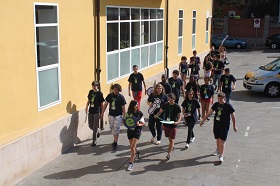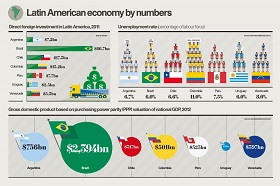Latin American Human Resources: Stagnation or Development
Miners, Bolivia
In
Login if you are already registered
(no votes) |
(0 votes) |
PhD (Political Science), Senior Research Fellow, RAS Institute for Latin American Studies
Demographically, Latin America is the world’s youngest region, and can therefore boast the largest population of working age. It is no coincidence the continent is flooded with investments, particularly from China. Labor issues are rightfully in the limelight, among them the portrait of the average Latin American worker, labor conditions, and economic sectors, youth issues, and migration flows.
Demographically, Latin America is the world’s youngest region, and can therefore boast the largest population of working age. It is no coincidence the continent is flooded with investments, particularly from China. Labor issues are rightfully in the limelight, among them the portrait of the average Latin American worker, labor conditions, and economic sectors, youth issues, and migration flows.
Latin America has, so far, experienced two powerful socio-demographic trends in the 21st century that are relevant to the labor environment. The first is the so-called demographic bonus phenomenon, meaning a minimal population ageing rate against a backdrop of diminishing mortality. Under these conditions, “employable persons aged 15-59 experience low pressure from the inactive population under 15 and over 59 years old.” [1] As a result, employable citizens obtain advantages over other age clusters, receiving new social openings for self-fulfillment, saving, jobs, etc.
The second trend is growing urbanization. Latin America is home to 10 out of 60 of the world’s largest cities [2]. Over the past 30 years its urban population soared by 240 percent, while the rural population grew by a mere 6.1 percent. In 1990, 70.6 percent of the region’s population were classed as city dwellers, and by 2010 this pan-regional figure had reached 79.9 percent, with 86 percent in Argentina, Uruguay, Chile and Venezuela [3]. In fact, Latin America has developed into one of the world’s most urbanized regions.
Latin America has, so far, experienced two powerful socio-demographic trends. The first is the so-called demographic bonus phenomenon. The second trend is growing urbanization.
The two processes combined give a potent quantitative push to the rise in the overall employable population, i.e. from 217 million to 274 million over the years 2000-2010, a phenomenon particularly visible among city dwellers. By 2020, Latin America’s workforce is expected to reach 327 million [4], which cannot but have an impact on labor-related issues such as employment and labor relations, the state regulation of labor politics, migration, etc.
The Latin American Labor Panorama
In the 1980s, the era of the lost generation, intensive neoliberal reforms and broadranging privatization effected an enormous contraction in Latin America’s public sector, which continued to diminish into the early 2010s. This situation is vividly illustrated by the sector-wide regional employment structure. According to the International Labor Organization (ILO), in 2011 only 12.7 percent of Latin America’s active population over 25 years of age were employed by the state, while 47 percent work at private small and medium enterprises (1.8-percent rise against 2008). The second largest group is made of the so-called independents (31.4 percent), i.e. self-employed workers in the informal sector covering small-scale retail, household production, private services, etc. This disproportion is even broader among the employable youth: 5.3 percent in the public sector, 63.4 in the private sector, and 13.6 percent – independent [5].
As far as labor distribution among sectors is concerned, we can observe two dominant trends, i.e. the outflow of workers from agriculture and processing. Latin Americans under 25 prefer employment opportunities in the service sector, the utilities included – 29 percent of the employable population (2011 ILO data). Trading comes second at 23.2 percent, followed by the extractive industries at 16.8 percent. Ironically, the latter’s employment capacity has dropped by 2.2 percent since 2005. Given growing activity in the extractive industries, chiefly oil and gas, the only explanation for this seems to lie in better technology ousting manual labor. The processing and construction sectors employ 12.4 percent and 7.6 percent respectively. Young people appear more attracted to commerce (29.1 percent) and the service sector (20.9 percent). In the material production sector they prefer extraction (18.6 percent) and processing (14.3 percent). The construction sector provides jobs to 7.8 percent of employable youths [6].
In 2012 and 2013, Latin America boasted record low jobless rates compared both with other world regions and its own past record. In 2011, the region-average figure was 6.7 percent, while the following year it fell to 6.4 percent, and by 2013 had reached 6.3 percent, a record low in the two past decades [7]. Analysts explain the expanding labor market by the region’s overall positive development in the post-crisis years. In 2013, the highest unemployment in the region rate was in Colombia (10.6 percent), Costa Rica (8.3. percent), Venezuela (7.8 percent) and the Dominican Republic (7.0 percent). The minimum levels were seen in Guatemala, Ecuador and Panama (under five percent) and in Brazil (5.6 percent) [8]. From 2005 to 2012 youth unemployment fell from 16.4 to 13.7 percent, although the average figure is still twice higher than for other age groups [9].
In 2012 and 2013, Latin America boasted record low jobless rates compared both with other world regions and its own past record.
How does the state approach unemployment and boosting employment? Due to the general weakness of Latin America’s public sector, the second problem has been totally transferred to private enterprises and corporations. The government's role in labor regulation is minimal and is essentially reduced to establishing a legal framework for business. As far as the first issue is concerned, the government’s social policies are focused on reducing and containing unemployment. In the past, government programs providing targeted allowances, i.e. one-off payments to ensure people still have the minimum living standards, have proved quite popular. In 2010, over 19.3 percent of the region's population, i.e. 113.5 million people were involved in these kinds of programs [10]. These payments could be regarded as poverty subsidies rather than unemployment benefits, but in any case, rather than stimulating the search for work, they generate paternalist sentiments.
Working Youth: 20th Century Atavism or 21st Century Key Potential?
In demographic terms Latin America is quite young, with a striking disproportion between its youth population and the global of young people aged 15 to 24 years of age. In 2013, the population of the region (including the Caribbean) amounted to 616.6 million; with a global population of 7.2 billion [12], meaning that the region is home to 8.5 percent of Earth's population [13]. According to the ILO, 56 million are already present on the labor market [14]. This age group offers the most complete picture of the region’s young people, since it "accumulates the key specific age-oriented expectations and has to focus on the main problem – education or work or combination of the two" [15].

Over the past several years, in 12 Latin
American countries (Argentina, Chile, etc.),
young people have been using the social
networks to set up voluntary service programs
(Aprendizaje-servicio) to plan and organize
various activities, disseminate information,
networking and education campaigns, with
students engaging in these activities benefit
from this activity being considered relevant
work experience and part of the curriculum
Predictably, young people form an extremely employment-vulnerable and unprotected group operating with minimal social support. Every second young person has no labor contract, with only 37 percent covered by medical insurance and 39.5 percent by retirement insurance. As a matter of fact, most Latin American youths (55.6 percent) work in the informal sector where the national labor legislation is virtually absent. This figure varies from country to country, with the highest percentage employed in the informal sector in Paraguay and Peru (at 70 percent), while in Uruguay and Costa Rica the situation is less critical at 24 and 14 percent, respectively. At the same time, there are some region-wide positive shifts. In 2005-2011, of the number of youths covered by contractual employment where the employer takes on a certain minimum amount of obligations (leave, overtime and protection from layoff) rose by 6.3 percent [16].
In order to compensate for these disadvantages, young people eagerly take on alternative jobs in line with current requirements, such as in crowdsourcing, i.e. self-organization of people for rendering services. Over the past several years, "in 12 Latin American countries (Argentina, Chile, etc.), young people have been using the social networks to set up voluntary service programs (Aprendizaje-servicio) to plan and organize various activities, disseminate information, networking and education campaigns, with students engaging in these activities benefit from this activity being considered relevant work experience and part of the curriculum." [17]
Intensive urbanization cannot but impact young people’s motivation to find employment, the key driver being the desire to become part of the urban middle class or to remain there. This frequently generates over-optimistic or even false expectations, such as stable pay, higher education, permanent and preferably comfortable housing, and a package of social benefits. However, Latin American economies are not strong enough to meet this need en masse, which fuels societal frustration, primarily among young people, but which also feeds a form of social escapism that turns into crime and drug addiction.
Experts maintain that the brain drain is gradually giving way to brain circulation, which better describes these inter-regional and inter-state labor migration processes.
Against this backdrop, there are a growing number of young people who are not in full time study or employment. They are known as the ni-ni phenomenon (Spanish for neither…nor). Currently, 21.8 million employable young people are in this category (20.3 percent, with 30 percent of them young men and 70 percent girls). They mostly belong to underprivileged social groups, 4.6 million of them are people who do not work from home and who are not actively seeking employment. This group lives on the margins of society and is often involved in crime.
Most analysts are confident that Latin American young people possess a huge but under-used adaptive and creative potential that matches the requirements of the digital epoch and that they can broadly be defined as a skilled labor force. According to the World Bank, in 1996-2007, the number of Latin American people who graduate from university increased from 23 to 40 million [18] and this figure is only continuing to rise.
Labor Conditions: Work and Pay

Ford factory, Mexico
The longest week is seen in Mexico and
Colombia (both 46 hours)
Hours are a fundamental condition in the working environment. Like the rest of the world, Latin America experienced a vital shift after World War Two, with the establishment of the 40-45-hour week. In the early 21st century, the region is the second best after Europe, with 42 hours per week (43 hours in 2002) [19] in 2011 against the 37-hour level seen in the Old World. This figure varies, with shortest week being in Venezuela, Honduras, Argentina and Peru (39 hours in 2011). Interestingly, in Peru and Honduras the working week fell from 41 and 44 hours respectively in 2002, whereas in Argentina it remained at its previous level, and in Venezuela rose to 37 hours. Meanwhile, in Europe over the same period, this figure shrank from 38 to 37 hours.
The longest week is seen in Mexico and Colombia (both 46 hours), Nicaragua, Bolivia and Paraguay (45 hours each), with the average length being that seen in Brazil, the Dominican Republic, Ecuador, Salvador and Uruguay (41 hours). Since 2002, the working week in all five states shortened by about three hours. Latin American men typically work two more hours a week than women.
The week is longer here than in Europe due to the high employment rate in the informal sector, where the working day is not regulated. By the late 2000s, this sector provided jobs to 93 million Latin Americans, i.e. about 50 percent of the active population [20].
The minimum wage is another key indicator of labor conditions. As of early 2013, the top rates were seen in Argentina (USD 617), Brazil (USD 328), Chile (USD 408), Costa Rica (USD 500.87), Honduras (USD 300), Venezuela (USD 429), and Paraguay (USD 385), while the lowest were seen in Bolivia (USD 143.68), Cuba (USD 10), Haiti (89.28) and the Dominican Republic (USD 149.32) [21]. Interestingly, younger workers earn 1.5-2.0 times less than adults. "Taking account of the high percentage of youths on low-paid jobs (Mexico, Ecuador, Uruguay – over 40 percent, almost 53 percent in Colombia), it is clear that working youths are terribly insecure." [22] As for the minimum wage, much depends on the purchasing power of the national currency. So, the dollar denominator would not provide a distinct picture, but would rather describe the immigration attractiveness of any particular state.
Labor Immigration: Latin America Rediscovered
The brain drain or labor migration flows from Latin America mostly lead to the United States and Europe, primarily Spain, which makes sense. Before the 2007-2008 economic crisis, emigration boomed, although it then declined somewhat and was followed by the reverse process, albeit only in the Spanish-European track. In 2009-2010, emigration to Spain and the United States dropped by 38 percent and four percent respectively [23].
Spain was hit hard by the economic crisis, causing recession and skyrocketing unemployment. The post-crisis times saw a significant rise in migration flows from Europe to Latin America, a process that was quickly labeled the Rediscovery of the New World, while Russian Latin America scholars defined it as the reverse wave effect [24]. About half a million people have moved from Europe to Latin America over the several past years, while in 2014, analysts expect a record high resettlement of 1.4 million [25].
Against this backdrop, inter-regional migration flows have also gained strength, with a better life and stable pay sought mainly in Argentina, Brazil, Chile and Uruguay. According to the International Migration Organization, in 2003-2013, over one million Latin Americans resettled to neighboring states, with the lion's share of 500,000 people preferring Argentina. Chile is the second largest recipient. Whereas in 2002 the country received 184,000 Latin Americans, in 2012 their numbers reached as many as 370,000 [26]. Some countries are literally experiencing an exodus. For example, in 2012 the Colombian migration services registered 180,000 applications for permanent residence from Venezuelans [27]. Urban migration within the countries is also on the rise, with the major cities clearly becoming labor attractors on a regional level.
Experts maintain that the brain drain is gradually giving way to brain circulation, which better describes these inter-regional and inter-state labor migration processes [28]. And these policies are becoming quite popular with some governments.
***
In short, Latin American labor is characterized by a number of contradictions and paradoxes. On the one hand, the regional economy is unable to prudently employ the population’s huge labor potential. Despite harder working conditions, the region has become attractive for workers from Europe. The clear disparity between the public and private sectors will continue to rise, and workers will continue to leave the regulated labor market for the informal sector. Only time will show whether the state will be able to shed its bystander role and go beyond the minimal palliatives on offer to more actively participate in resolving these problems.
1. E.E. Kuznetsova. Social Policies in Latin American Countries in early 21st Century: Continuity and Changes // Latin America journal, Issue №6, 2012, P. 14.
2. Source: http://www.manpower.cl/rrhh/documentos/5928__la_movilidad_del_talento_de_america_latina.pdf
3. Source: http://www.eclac.org/celade/proyecciones/basedatos_BD.htm
4. CEPAL Yearbook, AnuarioEstadístico de América Latina y el Caribe, 2013. P. 48.
5. TrabajoDecente y Juventud en América Latina 2013.Políticaspara la acción, ILO, 2013, P. 57. Source: http://www.ilo.org/americas/publicaciones/WCMS_235577/lang--es/index.htm
6. Ibid. P. 56.
7. Source: http://www.ilo.org/americas/sala-de-prensa/WCMS_228162/lang--es/index.htm
8. Source: http://www.un.org/spanish/News/story.asp?NewsID=28397#.U2tqktw2cW0
9. Source: http://www.ilo.org/americas/sala-de-prensa/WCMS_222817/lang--es/index.htm
10. E.E. Kuznetsova. Social Policies in Latin American Countries in early 21st Century: Continuity and Changes // Latin America journal, Issue №6, 2012, P. 18.
11. CEPAL Yearbook. AnuarioEstadístico de América Latina y el Caribe, 2013. P. 33.
12. Source: http://www.rpp.com.pe/2013-07-14-somos-mas-de-7-2-mil-millones-de-habitantes-en-el-planeta-segun-onu-noticia_613051.html
13. Nueva Sociedad jounal, Issue №243, enero-febrero 2013, P. 96. – www.nuso.org
14. Source: http://www.ilo.org/americas/publicaciones/WCMS_235577/lang--es/index.htm
15. E.E. Kuznetsova. How is it to be Young? (problems of Latin American Youth) (in print)
16. TrabajoDecente y Juventud en América Latina 2013.Políticaspara la acción, МОТ, 2013. P. 57. Source: http://www.ilo.org/americas/publicaciones/WCMS_235577/lang--es/index.htm
17. E.E. Kuznetsova. Latin American Youths – a Key Factor in Regional Modernization // Ibero-American Papers. Issue 1. Moscow. MGIMO-University, 2013, P. 301.
18. Source: http://www.lapatilla.com/site/2013/11/04/fuga-de-cerebros-dolor-de-cabeza-para-latinoamerica/
19. CEPAL Yearbook, Panorama Social de América Latina, 2013. P. 147.
20. Source: http://economiainformal.csa-csi.org/2012/01/31/oit-93-millones-estan-en-la-economia-informal/
21. Source: http://economia.com.ve/salarios-minimos-en-america-latina/
22. E.E. Kuznetsova. What is it like to be young? (Problems faced yb Latin American Youths) (in print)
23. Source: http://internacional.elpais.com/internacional/2013/01/22/actualidad/1358883206_977179.html
24. N.Yu. Kudeyarova. The Crisis and Migration: Reverse Wave Effect // Ibero-American Papers. Issue 1. Moscow, MGIMO-University, 2013
25. Source: http://www.excelsior.com.mx/global/2014/05/10/958488
26. Source: http://www.elcomercio.com/mundo/migracion-interregional-aumenta-America-Latina-inmigracion-inmigrantes-migrantes_0_890910924.html
27. Ibid. http://www.elcomercio.com/mundo/migracion-interregional-aumenta-America-Latina-inmigracion-inmigrantes-migrantes_0_890910924.html
28. Source: http://www.plazapublica.com.gt/content/cambiaron-el-termino-de-fuga-de-cerebros-circulacion-de-talentos-para-que-no-suene-tan-feo
(no votes) |
(0 votes) |






